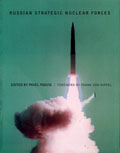 When Russia held its annual strategic exercise on 22 October 2025, the Chief of the General Staff said that the purpose of the exercise was to "practice the procedures for authorizing the use of nuclear weapons." This prompted me to check how the goals of these exercises were described in the past.
When Russia held its annual strategic exercise on 22 October 2025, the Chief of the General Staff said that the purpose of the exercise was to "practice the procedures for authorizing the use of nuclear weapons." This prompted me to check how the goals of these exercises were described in the past.
A big caveat is that we don't know if the stated goals of the exercises described in (usually brief) official statements have anything to do with the actual purpose of these exercises. The official statements are rather broad and vague anyway. For example, it's likely that testing of the authorization procedures is included in every such exercise, not just in the 2025 one. Having said that, here are the notes on past exercises in reverse chronological order:
According to the Chief of the General Staff, the goal of the exercise was to "practice the procedures for authorizing the use of nuclear weapons."
The exercise involved a mobile Yars launch from a Krona shelter, a launch of a Sineva SLBM, and launches of ALCMs from Tu-95MS bombers. The Krona shelter was a bit unusual (although not unprecedented - see the Yars launch in 2017, for example). One can imagine that this fits the declared goal of the exercise - mobile missiles in Krona shelters are on full alert and can be launched from there. After receiving authorization, of course.
I should note that the defense minister used the correct term, "strategic nuclear forces," after many years of "strategic offensive forces" (see below). I'd take it as a positive development, even if very small.
According to the defense minister, the exercise tested procedures of "a massive nuclear strike by the strategic offensive forces in response to a nuclear strike by an adversary" (0:15 in the video). Curiously, he said "strategic offensive forces (стратегические наступательные силы)," which is a term that is used in treaties but probably not quite appropriate in this context. "Strategic nuclear forces (стратегические ядерные силы, СЯС)" or "strategic deterrence forces" would have been better. This may be insignificant, but it does provide a glimpse into the inner workings of the military bureaucracy, which is ultimately responsible for putting together official statements. The text announcement did not mention any of that. It simply said that the exercise evaluated "the level of preparedness of military command bodies and the skills of command and operational personnel in organizing the management of subordinate forces."
The exercise itself included launches of a mobile Yars from Plesetsk, Sineva from Novomoskovsk submarine, and ALCMs from two Tu-95MS. In addition to these, the exercise included a launch of a Bulava missile from the Knyaz Oleg submarine deployed in the Sea of Okhotsk. It was the first Bulava launch from the Pacific Fleet. The initial plan was to do it in 2023, but the launch was moved to 2024 eventually.
The brief report on the Kremlin web site is very generic - "the level of preparedness of military command bodies and the skills of command and operational personnel in organizing the management of subordinate forces." Alas, there is no video, so if someone said something about a different objective, it hasn't been shown.
This was a standard exercise - a mobile Yars from Plesetsk, Sineva from a Project 667BDRM submarine (Tula this time), and ALCMs from two Tu-95MS. There was a plan to launch a Bulava from the Sea of Okhotsk, but it was cancelled.
The defense minister reported that the goal was to "work out tasks for delivering a massive nuclear strike by strategic offensive forces in response to an enemy nuclear strike." Note the "strategic offensive forces," which also appeared in 2024. My guess is that they just use a template without actually getting the language vetted by someone who would care about these things.
The composition of the forces that participated in the exercise is very standard - a mobile Yars, Sineva (from Tula submarine this time), and ALCMs from two Tu-95 MS.
This is the exercise that was supposed to take place in October 2021, but that was moved to February 2022 for reasons that became very clear five days later. The change of date may suggest that the decision to invade was made in early October 2021, although it's not conclusive as there are other ways to explain the move.
This time the description of the goals is very telling. The Chief of the General Staff said that the main goal of the exercise was to "work out procedures that allow strategic offensive forces to deliver guaranteed defeat to an adversary." The exercise was conducted in two stages. The first one was to "work out procedures for conducting operations with weapons of elevated potential danger." The second one was aimed at testing procedures for "sanctioning and massive employment of strategic offensive forces of the Russian Federation in a strike from under attack [otvetno-vstrechnyy udar]." (Note "strategic offensive forces" again.)
"Weapons of elevated potential danger" are clearly nuclear weapons. It's worth noting that the operations with these weapons were not supposed to be in response to anything. The scenario appears to have assumed that it would be Russia who would conduct these operations. And, presumably, the other assumption was that these operations would lead to an attack against Russia, which would then be forced to strike from under said attack. That was quite a scenario for the invasion that was planned to be launched on 24 February 2022. I actually think there is a good chance that the Russian leader was prepared to bear the risk of escalation all the way to the level of "massive attacks."
The types of weapons that participated in the exercise corresponded well to the scenario. In addition to the standard "strategic" part of the exercise--mobile Yars, Sineva (from Karelia), and two Tu-95MS--there was a non-strategic one. It included launches of a Kinzhal, Kalibr and Tsirkon (from submarines), as well as of an Iskander cruise missile at the Kapustin Yar test site.
In 2020, the exercise did not take place in October, although probably for a different reason than in 2021-2022. It was a COVID year and it is possible that it took the military some time to adjust to the pandemic. It was an almost standard exercise otherwise - a mobile Yars, Sineva, and ALCMs from strategic bombers. The "almost" qualifier is here because the exercise involved Tu-160 along with Tu-95MS. It's interesting that Tu-160 stopped participating in the fall exercises after 2020, although they continue to go on patrol a couple of times a year.
The event was described as an "exercise on the command and control of strategic offensive forces" that involved "practicing the practical actions of launcher crews." Not very detailed, but note the "offensive forces" again.
Another interesting note on the December 2020 exercise is that it was originally supposed to include a Bulava launch from a submarine of the Pacific Fleet. Russia released a corresponding NOTAM, but no launch took place on 9 December 2020. However, a launch took place a few days later, on 12 December 2020.
The 2019 exercise appears to be the last that had an official name, Grom-2019 in this case. It was also the last time the official announcement used the correct term, "strategic deterrence forces" (well, almost). It's "offensive forces" after that.
There was no official description of the scenario of the exercise, only a mention that "during the event, a verification was carried out of the preparedness level of military command bodies and the work skills of command and operational personnel in organizing command and control of subordinate forces." Of course it was.
The exercise involved a Yars launch, two SLBM launches--Sineva from Karelia in the Barents Sea and older R-29R from a Ryazan submarine from the Sea of Okhotsk--and ALCMs launched from Tu-95MS. It appears that more than the usual two bombers participated, since the ALCMs were launched toward two different test sites--Kura in Kamchatka and Pemboy in Komi Republic.
The good news is that at that point someone still cared about correct terminology. The official report describes an exercise of "strategic nuclear forces." As for the goal, it was not clearly described. The report just says that
During the exercise, the Armed Forces command system was tested, as well as the reliability of transmitting training and combat orders and signals through the entire command hierarchy from the National Defense Control Center of the Russian Federation to the command posts of formations and military units.
It's quite a mouthful, but passive voice is quite common in Russian (like in "mistakes were made"). I would say that it's probably close to the practicing of "the procedures for authorizing the use of nuclear weapons" that appeared in the 2025 report.
The 2019 exercise was quite unusual because it involved no ICBM launches. Or it looks like it did, but the launch was cancelled. The navy launched a Sineva from Barents Sea (Tula submarine) and R-29 from the Sea of Okhotsk. Both Tu-160 and Tu-95MS bombers took part in the exercise, along with Tu-22M3, which are technically included in long-range aviation.
Earlier exercises
I should probably stop here. We can see that at this point official announcements of the exercises had a somewhat different format and did not really include stated goals. It's interesting to note that the change to the new format coincided with the adoption of the term "strategic offensive forces" and with dropping the Grom name. I wouldn't be surprised if it was a result of a personnel change.
In terms of participating units, one can probably say that exercises have gradually become simpler. Even in the 2021/2022 one, the "strategic" part was pretty basic. The disappearance of Tu-160 is also somewhat interesting.
To conclude, here is the list of the fall exercises that I managed to locate in my blog:
- 26 October 2017
- 12 October 2016
- 30 October 2015
- 8 May 2014 (May !?)
- 30 October 2013
- 19 October 2012 - Topol ICBM, R-29R missile, bombers
- 12 October 2008 - Stabilnost-2008, Topol, SLBMs, bombers
I don't have a record of earlier large-scale exercises. I hope it's not because I missed them but because of the tradition of having a big exercise in the fall only started in 2012 (Stabilnost-2008 seems an outlier). In any event, it was useful to check the old records and to see how these exercises have evolved. At the very least, they are all in one post now.
(The image is from the 2017 exercise. The photo was taken by a Tomsk photographer Alexey Yakovlev)

Post a comment